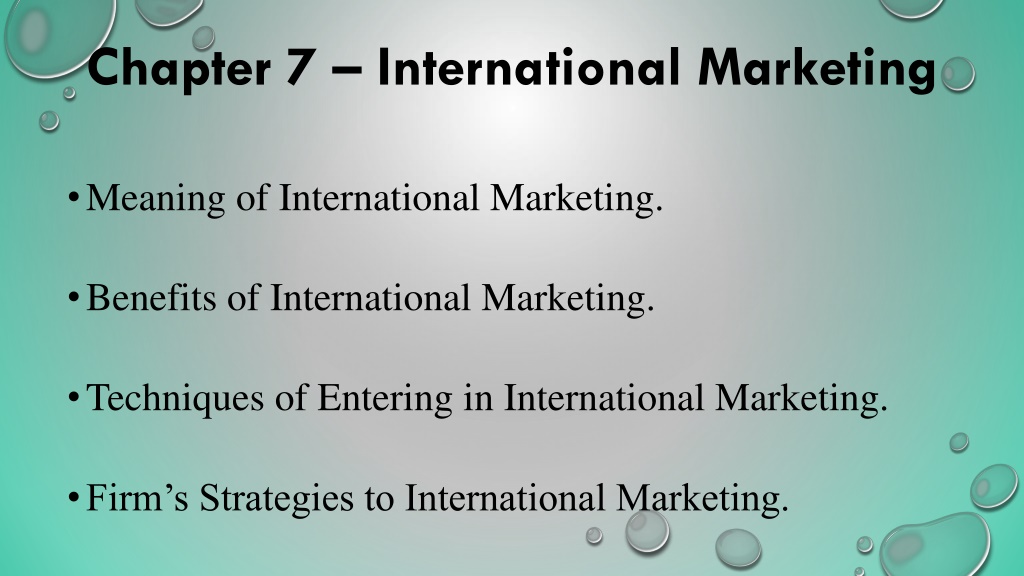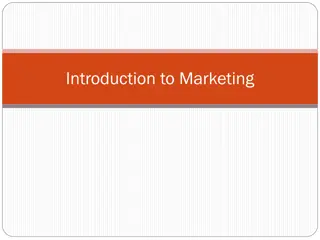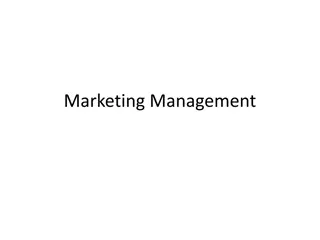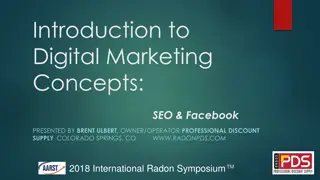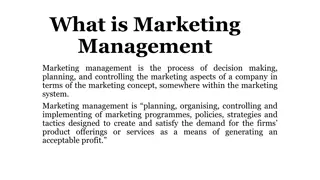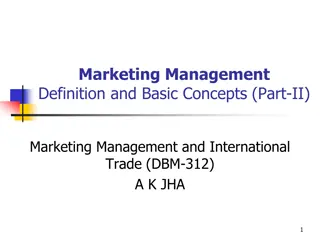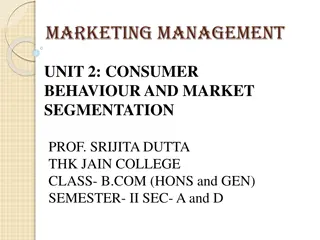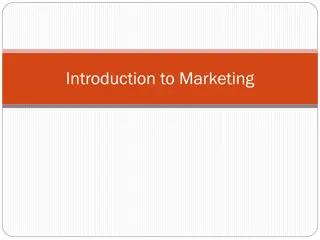Understanding International Marketing: Concepts, Benefits, and Strategies
International marketing involves planning, pricing, promoting, and distributing goods and services across multiple nations to meet global customer needs effectively. The American Marketing Association defines it as a multinational process aiming to satisfy individual and organizational objectives through exchange. Contrasting international and domestic markets reveal challenges and opportunities. Terminologies like international trade, market, and multinational corporation differentiate aspects of global business practices.
Download Presentation

Please find below an Image/Link to download the presentation.
The content on the website is provided AS IS for your information and personal use only. It may not be sold, licensed, or shared on other websites without obtaining consent from the author. Download presentation by click this link. If you encounter any issues during the download, it is possible that the publisher has removed the file from their server.
E N D
Presentation Transcript
Chapter 7 International Marketing Meaning of International Marketing. Benefits of International Marketing. Techniques of Entering in International Marketing. Firm s Strategies to International Marketing.
1. Meaning of International Marketing. International Marketing: is the performance of business activities designed to plan, price, promote, and direct the flow of a company s goods and services to consumers or users in more than one nation for a profit. International marketing: consists of finding and satisfying global customer needs better than the competition in both domestic and international, and of coordinating marketing activities within the constraints of the global environment. (Terpstra and Sarathy, 2000).
CONT The American Marketing Association (AMA):- defines the term international marketing as follows: International Marketing is the multinational process of planning and executing the conception, pricing, promotion and distribution of ideas, goods, and services to create an exchange tha1t satisfy individual and organizational objectives. Marketing concepts, processes, and principles are universally applicable, and the marketer s task is the same, whether doing business in Jimma, Texas, or Dar- es- salaam, Nirobi. Business s goal is to make a profit by promoting, pricing, and distributing products for which there is a market.
International Vs Domestic Market International Marketing Many languages, many nations, many cultures Domestic Marketing One language, one nation, one culture Markets are diverse and fragmented Market is much more homogeneous / Similar Multiple Currencies Single Currency Exchange controls and tariffs normal obstacles No problems of exchange controls and tariffs Multiple and unstable business environments Relatively stable business environments Due to national economic plans government Minimum government interference in influence usual in business decisions Marketing research very difficult, costly and cannot business decision Data in marketing research available, easily collected, and accurate give desired accuracy, etc. Marketing is more difficult Marketing is less difficult
Terminologies What Is The Difference Between International Trade International Market Global Market Multinational Corporation
Benefits of International Marketing Survival And Growth For companies to survive, they need to grow. because most countries are not as fortunate as the USA and China in terms of market size, resources, and opportunities, they must trade with others to survive. Most European nations are relatively small in size, they need foreign markets to achieve economies of scale so as to be competitive with American and Chinese firms. Sales And Profits Foreign markets constitute a large share of the total business of many firms that have wisely cultivated markets abroad. the case of Coca-Cola clearly emphasizes the importance of overseas markets. international sales account for more than 80 percent of the firm s operating profits.
CONT--- Diversification Demand for most products is affected by such cyclical factors as recession and such seasonal factors as climate. the unfortunate consequence of these variables is sales fluctuations, which can frequently be substantial enough to cause layoffs of personnel. One way to diversify a company s risk is to consider foreign markets as a solution to variable demand. Inflation and Price Moderation Imports can also be highly beneficial to a country because they constitute reserve capacity for the local economy. the lack of imported product alternatives forces consumers to pay more, resulting in inflation and excessive profits for local firms. Standards of Living Trade affords countries and their citizens higher standards of living than otherwise possible. without trade, product shortages force people to pay more for less.
Stages of International Marketing Involvement Once a company has decided to go international, it has to decide the degree of marketing involvement and commitment. These decisions should reflect considerable study and analysis of market potential and company capabilities. In general, one of five (sometimes overlapping) stages can describe the international marketing involvement of a company. Infrequent Foreign Marketing No Direct Foreign Marketing Regular Foreign Marketing Global Marketing International Marketing
No Direct Foreign Marketing a company in this stage does not actively cultivate customers outside national boundaries; however, this company s products may reach foreign markets. sales may be made to trading companies as well as foreign customers who directly contact the firm. web sites on the internet, many receive orders from international internet users. Infrequent Foreign Marketing temporary surpluses caused by variations in production levels or demand may result in infrequent marketing overseas. therefore, sales to foreign markets are made as goods become available, as domestic demand increases and absorbs surpluses, foreign sales activity is reduced or even withdrawn.
Regular Foreign Marketing at this level, the firm has permanent productive capacity devoted to the production of goods and services to be marketed in foreign markets. a firm may employ foreign or domestic overseas intermediaries, or it may have its own sales force or sales subsidiaries in important foreign markets. the primary focus of operations and production is to service domestic market needs.
CONT Global Marketing At the global marketing level, the most profound change is the orientation of the company toward markets and associated planning activities. at this stage, companies treat the world, including their home market, as one market. market segmentation decisions are no longer focused on national borders. instead, market segments are defined by income levels, usage patterns, or other factors that frequently span countries and regions. International Marketing Companies in this stage are fully committed to and involved in international marketing activities. such companies seek markets all over the world and sell products that are a result of planned production for markets in various countries. this planning generally entails not only the marketing but also the production of goods outside the home market.
Alternative Forms of Entering in International Market Read About Forms of Entering in International Market 1. Licensing 2. Contractual Agreements 3. International Alliances 4. Foreign Direct Investment
MARKETING STRATEGIES IN INTERNATIONAL MARKETING GLOBAL PRODUCT STRATEGIES Developing global product strategies requires knowing what types of products or services are product standardized and appropriate adaptation strategies. 1. PRODUCT STANDARDIZATION: High-end products also benefit from standardization, because quality and prestige often can be marketed similarly across countries. food and beverage marketers find it more challenging to standardize given widely varying tastes and cultural habits.
Product Adaptation Strategies Product Adaptation Strategies Product Communication Do not Change product Adapt product Develop new product Do not Change Communications Straight extension Product adaptation Product invention Backward invention Forward invention Adapt communications Communication adaptation Dual adaptation
GLOBAL PRICING STRATEGIES Companies Have Three Choices For Setting Prices In Different Countries: Set A Uniform Price Everywhere Set A Market-based Price In Each Country Set A Cost-based Price In Each Country
Distribution Strategy for International Marketing Seller's International Marketing Headquarters Channels between Nations Seller Final Buyers Channels within Foreign Nations
Paradigm Shift In Marketing Practice Around The Globe By Philip Kotler
PARADIGM SHIFT IN MARKETING From make-and-sell marketing to sense-and-respond marketing From owning assets to owning brands From vertical integration to virtual integration (outsourcing) From mass marketing to customised marketing From operating only in marketplace to operating in cyberspace From pursuing market-share to pursuing customer share From transaction marketing to relationship marketing
PARADIGM SHIFT IN MARKETING CONT From customer acquisition to customer retention and customer satisfaction From mediated marketing to direct marketing From marketer monologue to customer dialogue From single channel marketing to multi-channel marketing From product-centric marketing to customer-centric marketing From marketing department doing marketing to everyone in the company doing marketing From exploiting suppliers and distributors to partnering with them
I I thank thank G:\KINDYE\ISLAMIC\NN\03 TRACK 02.MP3 you ! you !
